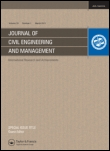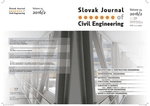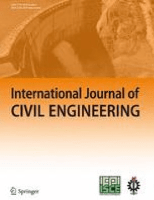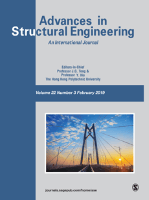
Advances in Civil and Architectural Engineering
Scope & Guideline
Shaping Resilient Communities Through Research
Introduction
Aims and Scopes
- Sustainable Construction Practices:
The journal emphasizes research on sustainable materials, energy-efficient designs, and innovative construction techniques that minimize environmental impact. - Structural Engineering Innovations:
It covers advancements in structural engineering, including novel materials, safety assessments, and seismic design strategies to enhance resilience in buildings. - Urban Development and Planning:
Research related to urbanization, infrastructure development, and the socio-economic impacts of architectural design is a core focus area, highlighting the interplay between urban growth and environmental sustainability. - Integrated Design and Technology:
The journal explores the integration of technology in civil and architectural engineering, such as smart materials, computational methods, and automation in construction processes. - Risk Management in Engineering Projects:
A significant aim is to assess and manage risks associated with engineering projects, including safety protocols, environmental risks, and economic feasibility.
Trending and Emerging
- Sustainable Material Innovations:
There is a growing emphasis on the development and application of sustainable materials, such as recycled aggregates and bio-based composites, which contribute to eco-friendly construction. - Smart and Resilient Infrastructure:
Research on smart technologies and resilient infrastructure is on the rise, focusing on how to enhance the durability and adaptability of structures in the face of climate change and natural disasters. - Energy Efficiency and Renewable Energy Integration:
Themes surrounding energy-efficient designs and the integration of renewable energy sources in building systems are increasingly prominent, reflecting global sustainability goals. - Advanced Computational Methods in Engineering:
The use of advanced computational techniques, including simulations and data analytics, is becoming more prevalent, enabling more precise modeling and optimization in engineering projects. - Environmental Impact Assessments:
There is a heightened focus on assessing the environmental impacts of construction projects, ensuring that sustainability is a key consideration in planning and execution.
Declining or Waning
- Traditional Materials and Techniques:
Research focusing solely on conventional construction materials and methods is becoming less prevalent, as the field shifts towards innovative and sustainable alternatives. - Basic Theoretical Studies without Practical Application:
There is a noticeable decline in papers that present theoretical frameworks without a clear application or relevance to current engineering challenges or industry practices. - Generalized Urban Studies:
While urban development remains a focus, broader studies that do not address specific challenges or innovative solutions in urban planning are seeing reduced interest. - Non-Sustainable Practices:
Papers that promote or examine non-sustainable practices in construction and architecture are increasingly rare, reflecting a broader commitment to sustainability in the field. - Purely Historical Analyses of Engineering Practices:
Research that focuses solely on historical perspectives without linking to contemporary engineering practices or lessons learned is becoming less common.
Similar Journals

Journal of Civil Engineering and Management
Exploring the intersection of engineering excellence and management prowess.Journal of Civil Engineering and Management, published by Vilnius Gediminas Technical University in Lithuania, is a prominent open access journal dedicated to the dissemination of cutting-edge research in both civil and structural engineering as well as strategic management. With the ISSN 1392-3730 and E-ISSN 1822-3605, this journal has been an essential resource for academics and industry professionals since its inception in 2002 and has continued through to 2024. Recognized for its high-quality publications, it ranks in the Q2 quartile in both the fields of Civil and Structural Engineering and Strategy and Management, reflecting its significant impact in the academic community with a Scopus ranking of #75 out of 379 and #121 out of 478 respectively. The journal embraces an open-access model, promoting wider distribution and accessibility of knowledge to foster innovation and collaborative advancements in construction practices and management strategies. It serves as a vital platform for researchers, professionals, and students looking to contribute to and stay informed about the latest developments in these dynamic fields.

Turkish Journal of Civil Engineering
Transforming Ideas into Engineering ExcellenceWelcome to the Turkish Journal of Civil Engineering, a pioneering publication under the auspices of the TURKISH CHAMBER OF CIVIL ENGINEERS, dedicated to advancing the field of civil engineering and construction. With a focus on cutting-edge research and innovative practices, this journal seeks to provide a platform for scholars, professionals, and students to share their findings and insights within the sphere of civil and structural engineering. The journal is committed to open access, ensuring that research is readily available to a global audience. As it embarks on its journey from 2023 to 2024, it aims to enhance its reputation as a vital resource within the academic community, currently ranking in the 40th percentile for Building and Construction Engineering and 32nd for Civil and Structural Engineering in Scopus. We encourage contributions that push the boundaries of engineering knowledge, fostering collaboration and progress in this essential field.

Slovak Journal of Civil Engineering
Fostering collaboration for a sustainable engineering future.Welcome to the Slovak Journal of Civil Engineering, a premier open-access publication dedicated to advancing the field of civil engineering. Published by SCIENDO, this journal has been providing a platform for the dissemination of groundbreaking research since 2010, ensuring that all articles are freely accessible to a global audience. With a commitment to promoting innovation and excellence within civil engineering, the journal covers a wide range of topics, including structural engineering, transportation systems, geotechnics, and environmental engineering. The Slovak Journal of Civil Engineering is designed to engage a diverse community of researchers, professionals, and students, fostering collaboration and knowledge-sharing to address contemporary challenges in the field. With its open-access model, the journal not only enhances visibility for authors but also ensures that the latest findings and methodologies reach practitioners and academics alike, making it an essential resource for anyone interested in civil engineering advancements. Stay connected with the evolving landscape of civil engineering through this influential publication.

Periodica Polytechnica-Civil Engineering
Unveiling Innovations in Structural IntegrityPeriodica Polytechnica-Civil Engineering is a prestigious journal published by the Budapest University of Technology and Economics, dedicated to advancing the field of civil engineering through high-quality research and innovative practices. Established in 1972, the journal has transitioned through various phases of publication and now spans an expansive range of topics within civil and structural engineering, geotechnical engineering, and engineering geology. With an impact factor indicating its growing influence and a commendable placement in the Q3 quartile according to the latest 2023 metrics, it recognizes contributions that bridge theoretical advancements with practical applications. While currently not open access, the journal remains a vital resource for researchers, professionals, and students seeking to stay abreast of the latest developments in engineering design, construction techniques, and geotechnical innovations. The continuous publication of significant research after almost five decades underscores its commitment to disseminating knowledge crucial for the world’s infrastructure challenges, making it an essential reference point within the engineering community.

Magazine of Civil Engineering
Transforming Ideas into Structures: The Voice of Civil EngineeringMagazine of Civil Engineering, published by ST-PETERSBURG STATE POLYTECHNICAL UNIVERSITY, is a prominent open access journal dedicated to the field of civil and structural engineering. With an ISSN of 2712-8172 and E-ISSN 2071-0305, it serves as a vital platform for disseminating high-quality research, innovative methodologies, and current trends in building and construction. Since its inception in 2010, the journal has embraced open access, ensuring broad visibility and accessibility for its contributions to the academic community. The magazine holds a respectable position in the academic hierarchy, ranked in the Q3 quartile for both Building and Construction and Civil and Structural Engineering categories as of 2023. It is indexed in Scopus, amplifying its societal impact and reach with a rank of #114/223 in Building and Construction and #224/379 in Civil and Structural Engineering. Researchers, professionals, and students alike are encouraged to engage with the cutting-edge studies presented in the magazine, contributing to the advancement of knowledge and practice within the civil engineering domain.

Gradevinar
Connecting Ideas, Building Futures in Civil EngineeringGradevinar, published by the Croatian Society of Civil Engineers-HSGI, is a leading Open Access journal in the field of Civil and Structural Engineering, with a significant history that dates back to its inception in 1980. This journal, with the ISSN 0350-2465 and E-ISSN 1333-9095, has established itself as a vital platform for disseminating innovative research and practical developments in civil engineering, particularly since it became Open Access in 2000, facilitating unrestricted access to its wealth of knowledge. As of 2023, Gradevinar is ranked in the third quartile (Q3) of Scopus’s Civil and Structural Engineering category, demonstrating its growing influence and relevance in the academic community, with a current ranking of #255 out of 379 journals in the field. Researchers, professionals, and students benefit from this journal's commitment to high-quality content that reflects the latest advancements and best practices in civil engineering, contributing to both technical proficiency and sustainable development in infrastructure projects across Croatia and beyond.

Architecture Civil Engineering Environment
Exploring New Frontiers in Civil Engineering and Environmental ScienceArchitecture Civil Engineering Environment, published by Silesian University of Technology, is an esteemed open-access journal dedicated to advancing research and scholarship in the fields of architecture, civil engineering, and environmental science. With its ISSN 1899-0142 and E-ISSN 2720-6947, the journal facilitates the dissemination of innovative practices and methodologies to an international audience. Since transitioning to open access in 2016, it has fostered a collaborative environment that empowers researchers and professionals to share their work freely, thus enhancing the visibility and impact of contemporary studies. The journal emphasizes interdisciplinary research, aiming to bridge gaps between architectural design, civil infrastructure development, and environmental sustainability. By publishing high-quality peer-reviewed articles, Architecture Civil Engineering Environment plays a crucial role in shaping the future of sustainable practices within these intertwined disciplines, making it an essential resource for scholars, practitioners, and students alike.

International Journal of Civil Engineering
Transforming Challenges into Engineering ExcellenceThe International Journal of Civil Engineering, published by Springer International Publishing AG, is a premier platform dedicated to advancing the field of civil engineering. With a notable impact factor and a strong reputation reflected in its Q2 quartile rankings in both Civil and Structural Engineering as well as Geotechnical Engineering and Engineering Geology, this journal facilitates the dissemination of high-quality research from 2009 through 2024. Researchers and professionals can access cutting-edge studies and innovative practices that address contemporary challenges in civil engineering, such as sustainable infrastructure development, environmental impacts, and advanced material technologies. Situated in Switzerland, the International Journal of Civil Engineering emphasizes the critical interplay between theory and application, making it an essential resource for students, academics, and industry leaders seeking to stay at the forefront of their disciplines.

CANADIAN JOURNAL OF CIVIL ENGINEERING
Building the Future Through Research and DevelopmentCanadian Journal of Civil Engineering, published by Canadian Science Publishing, serves as a premier platform for the dissemination of innovative research and development in the fields of civil and structural engineering, as well as environmental science. Established in 1971, this journal maintains a robust reputation, achieving a Q3 ranking in both civil engineering and general environmental science categories as of 2023. While it does not currently offer open access, the journal is accessible to a wide audience of researchers, professionals, and students who are keen to stay abreast of the latest advancements in civil engineering practices. With a significant number of yearly publications and a committed editorial board, the Canadian Journal of Civil Engineering contributes to the foundational knowledge and practical applications in the engineering community, thereby playing a critical role in addressing contemporary challenges in civil infrastructure and environmental sustainability.

ADVANCES IN STRUCTURAL ENGINEERING
Leading the Charge in Sustainable Building PracticesADVANCES IN STRUCTURAL ENGINEERING, published by SAGE PUBLICATIONS INC, is a leading journal dedicated to the advancement of knowledge in the fields of Building and Construction, as well as Civil and Structural Engineering. With a solid impact factor and a commendable Scopus ranking (Rank #60 in Building and Construction, Rank #105 in Civil and Structural Engineering), this journal stands at the forefront of academic research, providing a platform for high-quality articles that contribute significantly to the discipline. Covering a range of topics from innovative construction techniques to sustainable engineering practices, the journal aims to foster collaborative dialogue among researchers, industry professionals, and students alike. As of 2023, it boasts impressive category quartiles, ranking Q1 in Building and Construction and Q2 in Civil and Structural Engineering. ADVANCES IN STRUCTURAL ENGINEERING is a vital resource for those looking to stay abreast of emerging trends and groundbreaking developments in structural engineering, promoting an environment of continuous learning and application of best practices. With a convergence of research from 1999 to 2024, the journal not only emphasizes theoretical frameworks but also bridges the gap between academia and practical application in engineering projects.